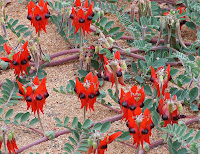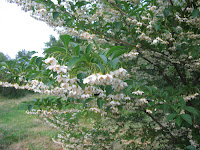Chiranthodendron pentadactylon – Sterculiaceae (Malvaceae) - ‘Devil's Hand Tree,' 'Monkey's Hand Tree,' 'Mexican Hand Tree,' 'Árbol de la manita,' 'Flor de la manita,' 'Mano de león,' 'Palo de yaco,' 'Mano de mico,' 'Majagua,' 'Macpalxochicuahuitl' -
Once known from a single sacred specimen growing in the Valley of Toluca in México, it was revered by the Aztecs and used spiritually and medicinally. Similar to an American Gingko, this plant was later found growing wild in the mountains of the México-Guatemala border, but much of the mystique surrounding this plant remains. It's names, both common and latin, refer to the excerted stamens emerging from the flower like a clawed hand.  Like its close relative, Fremontodendron, it is in the Chocolate family, and a cross between the two genera is also grown. Difficult-to-germinate seeds mean that this plant is still rare in cultivation, but there are many fine specimens dotted up and down California.
Like its close relative, Fremontodendron, it is in the Chocolate family, and a cross between the two genera is also grown. Difficult-to-germinate seeds mean that this plant is still rare in cultivation, but there are many fine specimens dotted up and down California.
Devil's Hand Tree is a slow-growing tree that will eventually reach a rounded 50'-60', and has a very beautiful contorted branches. The wonderful large red flowers put on a great show and flower for a long season. On the ground you sometime find the 'hands' that have fallen out of the mature flowers- a strange sight indeed (pictured). A tree for full sun on the cost or part shade more inland, they are very drought tolerant once established, and can also tolerate brief dips below 20º F.
 Like its close relative, Fremontodendron, it is in the Chocolate family, and a cross between the two genera is also grown. Difficult-to-germinate seeds mean that this plant is still rare in cultivation, but there are many fine specimens dotted up and down California.
Like its close relative, Fremontodendron, it is in the Chocolate family, and a cross between the two genera is also grown. Difficult-to-germinate seeds mean that this plant is still rare in cultivation, but there are many fine specimens dotted up and down California.Devil's Hand Tree is a slow-growing tree that will eventually reach a rounded 50'-60', and has a very beautiful contorted branches. The wonderful large red flowers put on a great show and flower for a long season. On the ground you sometime find the 'hands' that have fallen out of the mature flowers- a strange sight indeed (pictured). A tree for full sun on the cost or part shade more inland, they are very drought tolerant once established, and can also tolerate brief dips below 20º F.





































